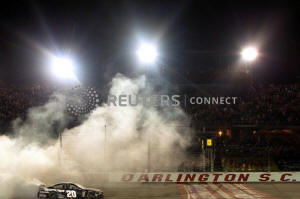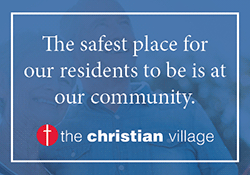NASCAR's U-turn to racing raises
flags of uncertainty, change
 Send a link to a friend
Send a link to a friend
 [May 09, 2020]
NASCAR is back. [May 09, 2020]
NASCAR is back.
On May 17, the roar of engines - albeit without the roar of the
crowd - will return to a NASCAR Cup Series race track. And when the
competitors do arrive at Darlington Raceway in South Carolina that
Sunday, it will be amid an air of apprehension and uncertainty.
"I don't know that right now there's many procedures that are
business as usual, so to speak," Cliff Daniels, crew chief for
seven-time Cup champion Jimmie Johnson, said.
The circuit will be busier than ever making for up for lost time.
Five races are scheduled between the return run at Darlington (May
17) and Kansas two weeks later.
Creating the apprehension and uncertainty is the fact that not only
have NASCAR teams not competed in an actual race at an actual track
in almost two months because of the suspension of the season due to
the Coronavirus pandemic, but team members have not been able to lay
a wrench on their race cars and drivers have been, basically,
limited to cyber training and racing.

Johnson, who had planned to retire following the 2020 season,
admitted flat out: "We're in unchartered territory here" in terms
of, well, everything.
NASCAR competitors last raced on March 8 in Phoenix.
During the layoff, NASCAR officials spent many hours discussing,
shaping and planning the remainder of the 2020 season.
Ultimately, NASCAR decided it needed to stage all 36 races on the
original schedule. To do that, the schedule has been significantly
jumbled to accommodate events that were postponed by the coronavirus-forced
hiatus.
Twice this month, for example - at Darlington and Charlotte Motor
Speedway - double-header events will be held. In addition to Sunday
races, others will be held on Wednesday evenings: weekend races will
be held three days before, and then four days after the mid-week
events.
For drivers and crew members, physical conditioning before racing
resumes has been of prime importance.
Stewart-Haas Racing's Kevin Harvick, who entered the hiatus as the
series points leader, has been logging time in go-karts in an effort
to get his upper body ready for the beating of an intensified
schedule.
Some pit crew members have been staying in shape by way of unique
exercises.

Greg Ives, crew chief for Hendrick Motorsports driver Alex Bowman,
said, "My tire changer, he's into some sword game. I don't know, he
sent me some optical game he was playing. My jack man, he said he's
working out with his fiancé and it puts him to another level because
of the flexibility and agility that she does; he really doesn't
incorporate (that kind of workout) into his stuff. Everybody is
getting a different taste of what they are not comfortable with."
Daniels said he thinks his team might be a bit ahead of others when
it comes to preparation. He said his team had already prepped the
Chevrolet Camaros it will use at Darlington.
"Once we get into some weeks where you're racing three times in
seven days, the cars on the backside of that schedule, we'll see how
good we really are at executing and getting all the details met," he
said.
Big changes are waiting for teams at the race tracks - starting at
Darlington, and then at Charlotte Motor Speedway for a twin-bill the
week after.
"That race will include live pit stops," said NASCAR executive vice
president and chief racing development officer, Steve O'Donnelll.
"It was important for us to be able to showcase a race as close to
what normally takes place as possible. But it was also important for
us to minimize what activity took place leading up to the event.
That's why we don't have practice or qualifying prior to that event.
"Then Wednesday (May 20th) we'll go back with the second Cup race,
500 kilometer. Again, no practice or qualifying, but live pit
stops."
[to top of second column] |

NASCAR Cup
Series driver Erik Jones (20) celebrates after winning the Bojangles'
Southern 500 at Darlington Raceway. Mandatory Credit: Joshua S.
Kelly-USA TODAY Sports/

For the time being fans will not be allowed into the track, meaning
a portion of the 2020 Cup schedule will be conducted in front of
empty grandstands.
"For me," Johnson said of race viewing being confined to television,
"it's a real simple answer. There are millions that watch on
television, and I don't want to deprive the greater sum because we
can't have the fans in the stands. And I get it. I want fans in the
stands. They deserve to be there. We want them there. There's an
energy that comes with it. But we are in uncharted territory and
we're going to have to do things a little different than what we're
used to. And if we can get back to the track months before because
fans aren't in the stands, and provide our sport to millions and get
people back to work and some normalcy going on in our country and
our industry, I'm definitely for that."
Life in the pits and garages will be affected as well.
"Events are going to look different than they have in the past,"
said John Bobo, NASCAR vice president of racing operations. "The way
we travel to the event, the way we enter the event, move about in
the event, the way we leave an event is going to be different.
"Everybody going into the infield is going to be wearing cloth masks
as they move about. Since there will be no spectators, no fans in
the infield, we'll be able to use the entire infield to space out
and socially distance. We'll be able to space out the car garages.

"With social distancing, we're going to have one-way walkways for
people, our rules strictly enforced. If people aren't complying with
our rules for masks and social distancing, they will be removed from
the premises."
Back at the race shops -- more changes.
Daniels said the intermingling of crew members has been limited.
Much of the communication between crew members and between crews and
drivers has been done via video conferencing, "phone, text, and
workplace chat software" at Johnson's Hendrick Motorsports.
Drivers, many of whom have competed in "iracing" events during the
hiatus, seem excited about returning to actual racing.
Team Penske driver Brad Keselowski said via Twitter late last month,
"Things will look different when we return but the changes are
necessary for the safety of everyone who makes our races successful,
especially our fans."
The 2020 season was supposed to be Johnson's final go as a full-time
Cup driver. The interrupted season put a damper on his swan song.
"Sure," he said, "I want to be on track. Sure, I want to go to these
places a final time. I feel more for the fans that aren't having
that opportunity right now that I long for myself to experience it
and to be there, if that makes any sense. And that's only a small
piece in the grand scheme of things when you look at all the
individuals that are affected by the Coronavirus and the families
that have been affected, and the economy, and businesses and
business owners. This is way bigger than me and way bigger than what
was going to be my final time at these tracks."

Before the hiatus, only four of the season's 36 races had been run.
Winning those events were Denny Hamlin of Joe Gibbs Racing (the
Daytona 500), Chase Elliott of Hendrick (in Las Vegas), Bowman (in
Fontana, Calif.) and Team Penske's Joey Logano (Phoenix).
--By Jim Pedley, Field Level Media
[© 2020 Thomson Reuters. All rights
reserved.] Copyright 2020 Reuters. All rights reserved. This material may not be published,
broadcast, rewritten or redistributed.
Thompson Reuters is solely responsible for this content. |